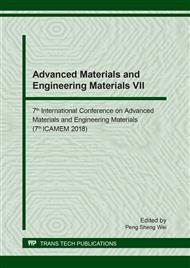p.8
p.13
p.17
p.22
p.27
p.32
p.37
p.44
p.50
Enhancing Mechanical Properties of Polyvinyl Alcohol Fiber Reinforced High Density Polyethylene Composites
Abstract:
In this work, high density polyethylene (HDPE)/polyvinyl alcohol (PVA) fiber composites have been fabricated via melt compounding by employing a twin-screw extruder. The resulted composites samples of four different PVA loadings (i.e. 0, 5, 10, 20 wt%) were then characterized via tensile test to investigate the effect of PVA loadings on their mechanical properties (i.e. modulus elasticity, tensile strength, toughness, and strain at break). Additionally, the surface morphologies of the composites (i.e. cryo-fractured and tensile fractured samples) were also studied by using a scanning electron microscopy (SEM). The SEM micrographs on the cryo-fractured sample showed that PVA fibers were perfectly embedded and well blended in HDPE matrix. Whereas, the SEM images of tensile-fractured samples showed that there was a fibrillation effect on the neat HDPE, while in the composites sample, there was an evident of broken fibers. Additionally, from the tensile test results, the modulus elasticity of the composites has increased by approximately 16, 39, and 81% (as compared to the neat HDPE) for PVAC-5, PVAC-10, and PVAC-20, respectively. Whereas, the toughness and strain at break of the composites have decreased.
Info:
Periodical:
Pages:
27-31
Citation:
Online since:
August 2018
Price:
Сopyright:
© 2018 Trans Tech Publications Ltd. All Rights Reserved
Share:
Citation:


